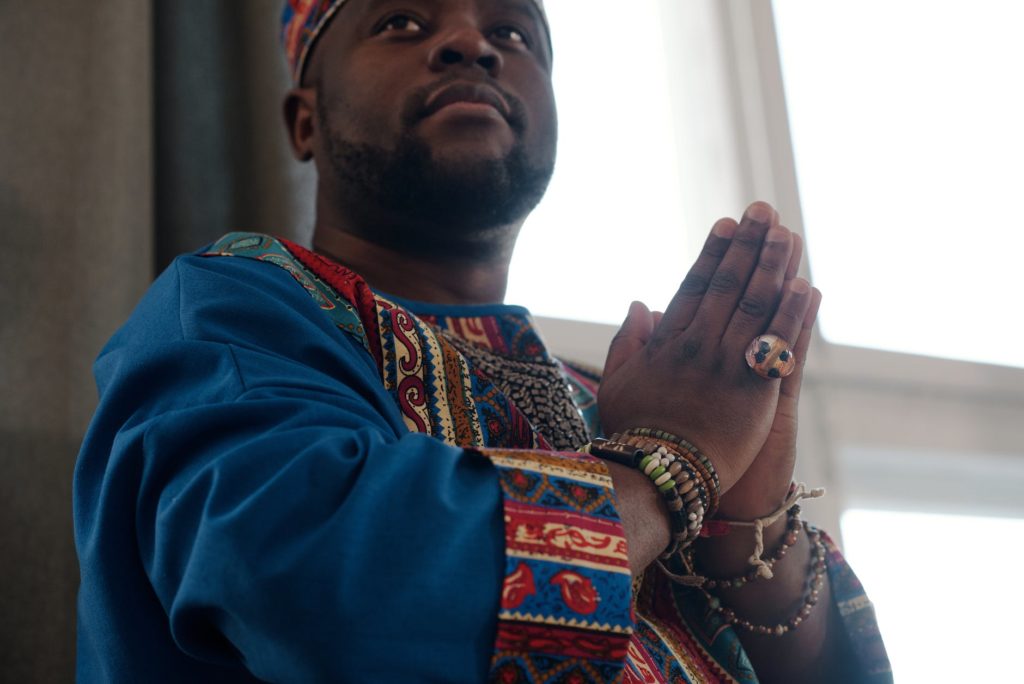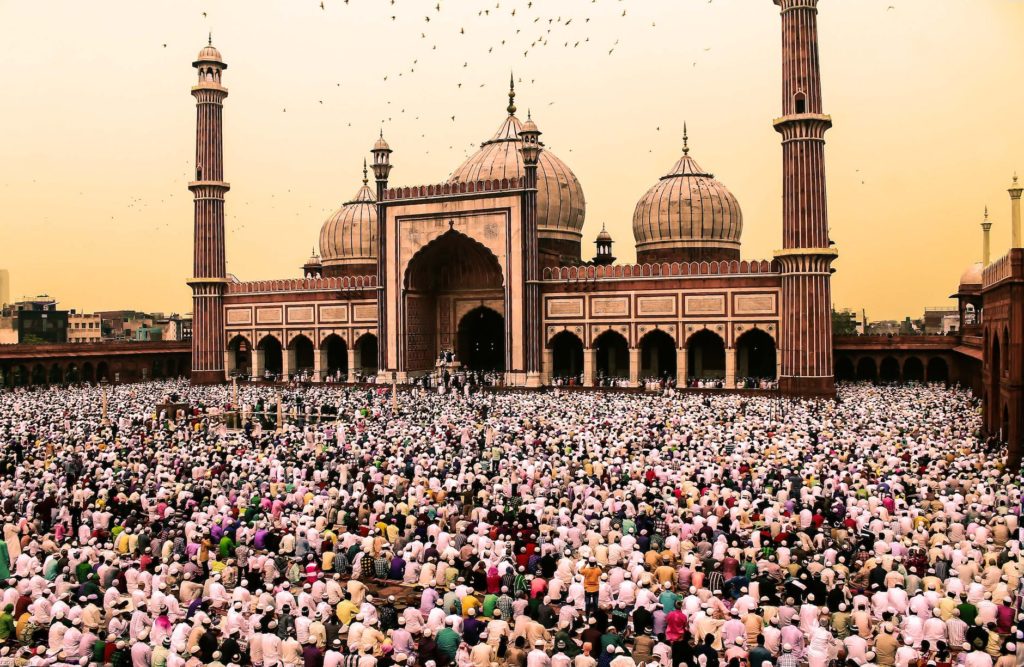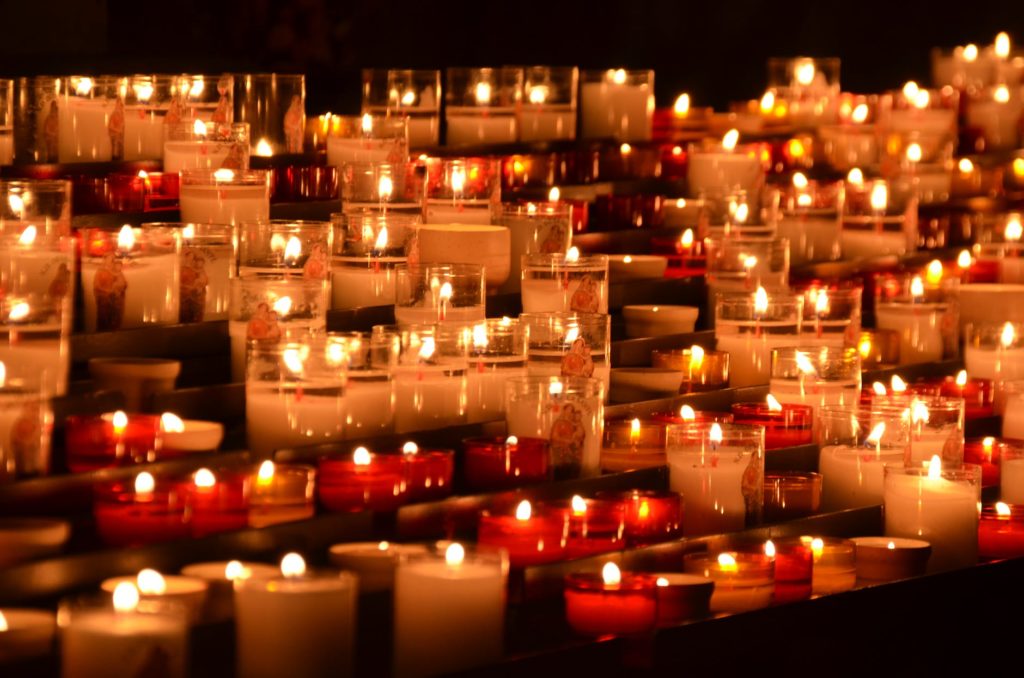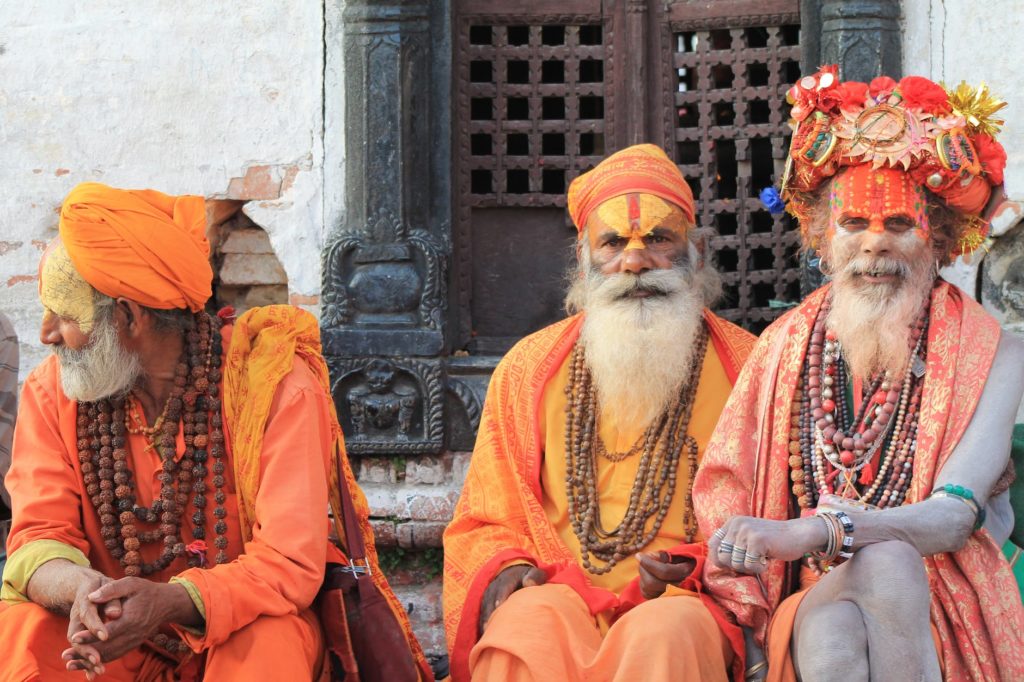Summary
This document provides some commentary and news about the state of world religions. A better understanding of diverse views helps promote more effective interactions between people.
Four Major Religions
When measured by the number of adherents, there are only four major religions in the world: Christianity (31%), Islam (24%), Hinduism (15%), and Buddhism (7%).
Minor religions, such as Sikhism (0.3%) and Judaism (0.2%) are overshadowed by folk religions (5.7%) and those who don’t claim any religion (16%).
If you don’t see your own religion listed here, it is because it’s part of a sub-category.
Within the various religious groups listed above, there are numerous movements, sects, factions, and splinter groups.
Stuck in Time
For religions that have roots going back many years, some present-day adherents seem to be living in a different era with regard to their clothing and customs.
This is true for some Buddhists, Amish, Mennonites, Monks, Nuns, Greek Orthodox, and Hassidic people.
For these groups, the simplicity of a specific historic period may be considered to have value. It creates a consistent backdrop in one’s life to bring focus to the principles of faith one is pursuing. Living according to the historic culture of a religious founder is a way of remembering the founder and the early followers of the faith. It also creates a point of unity among followers.
8 Billion People
On 15 Nov 2022, the world population reached 8 billion people according to an announcement by the UN. This means we now have 8 billion unique perspectives on life. Regardless of what religion a person is born into (or adopts), they will individually need to apply that faith or philosophy to the unique choices and challenges life presents. They will shape how their own story unfolds. This becomes their unique expression of faith. Some religions attempt to create as much uniformity as possible, yet individuality remains.
Even those who don’t profess to have a religion are establishing a way of life or philosophy they live by. For purposes of this document, religion, world view, or a philosophy are similar.
Religious Persecution
Religious persecution can occur within groups of the same religion where differences of interpretation and practice exist, or as a result of struggles for dominance and power. Sometimes members and non-members are harshly punished if they don’t conform to the rules of a dominant religion in a country or region. This is usually to instill fear in others and bring about unquestioning conformity.
Non religious people are sometimes looked down on and persecuted. On 6 Nov 2022, the BBC posted a 25-minute documentary-style news report about Mubarak Bala, the president of the Humanist Association of Nigeria. [View Report] He had some questions about the dominant religion in Nigeria, and he professed to be an atheist. As a result, he was arrested for blasphemy. This is an example of the a negative outcome when extremist intolerant religious people gain too much control.
Joining a Religion to Escape Persecution
As a result of religious intolerance, people will join whatever religious group is less likely to result in persecution. The choice isn’t from the heart, but only from the desire to belong and be accepted. In families, a person’s religion is usually assumed to be that of the parents and ancestors.
Depending on the region or country, minority religions may be persecuted, in most cases because they are different, viewed as outsiders, and are not well known.
There’s usually nothing specific about the minority group that is offensive. As with most bigotry or racism, hatred is directed to a group that one knows little about. Or, there is fear based on rumors and misinformation about the minority group.
Weak in Faith = Loud in Threats
Religious people who are weak in their faith, and uneducated about the world, are more likely to be militant about defending and spreading their faith.
They are insular — not to be inspired by like-minded believers, but out of fear that the perceived temptations of the world might cause them to slip from their faith.
They don’t have answers to the difficult questions, so they oppress those who ask them.
Mature in Faith
At a certain level of maturity, one develops a love for the world. Such a person doesn’t see questions as a threat, but an opportunity to connect and grow.
For people mature in their faith, the temptations of the world are replaced with a desire to go deeper in their own practice.
Overly Religious People
People who are viewed as excessively religious and observant can be a target for ridicule. This is partly because they are typically a minority group.
Their religious practice might be perceived by some as a non-verbal criticism of those who aren’t as observant.
People can be uncomfortable around others who seem stuffy or judgmental. For example, people feel uncomfortable swearing around a person who doesn’t swear, for fear of being judged or offending them.
Isolation Misunderstood
Some religious traditions promote isolationism. The Shaolin Monastery is in a relatively remote area of China. Training is intensive and takes years. Being immersed in a community of like-minded people helps to reinforce the training. Similarly, nuns, Hassidic Jews, Mennonites, and Amish people generally remain in their own communities.
Olympic training requires a similar level of intensity and commitment as religious training. This is why Olympic training centers are residential experiences that can last months. Accommodations are similar to a convent.
It’s reasonable to think we can admire any group or discipline that seeks to flourish and grow in isolation.
Expanding Love
People who are religiously observant to the point of transcendent mysticism develop a love for everyone. This is why the Pope, the Dalai Lama, and mystic Rabbis, care about all humanity and their message is for everyone. Individuals like Israel ben Eliezer, Mother Theresa, or The Rebbe are viewed as being inspirational world leaders.
The most religious people in the world should see non-religious people as allies. Both groups are persecuted for their minority beliefs. At a mature level of understanding, it’s the natural position to express acceptance of people who are different.
Religions Unify and Divide
Religions unify and also divide people. They unify by bringing people together under common beliefs, and offering a genuine feeling of belonging. They divide people when differences of interpretation exist.
As people arrive at different conclusions about the best way to practice their faith, there can be divisions. Some members of the religion will say, “Meh… These little details don’t really matter. What matters are the main principles of the faith and that we treat everyone with kindness.” That group may break away to form some new movement that’s considered to be more tolerant.
Those who remain, debate specific meanings of sacred text, teachings, and commands to determine the requirements of the faith. This inevitably results in schisms over certain practices. Sometimes these distinctions are minor, such as whether to use buttons, snaps, pins, or hook-and-eye with garments. Other splits among religious groups are more significant, such as with the founding of Lutheranism. The bigger schisms are typically among those who are passionate and serious about their faith to the point of being willing to fight over doctrine.
Division can result in great unity for the resulting subsets. They are at a peak of doctrinal agreement — with those in each faction affirming their own doctrinal interpretations and decisions.
When under persecution, groups become more defined, strong, and defensive of their members. They are more committed than ever. We think of turmoil and splits in an organization as being something that weakens, and yet there can also be a strengthening aspect to it.
Uniformity and Individuality
For some individuals, there can be an appeal to being part of an organization that prescribes what a person is to eat, wear, and think.
Whether a business branded uniform, or military uniform, or religiously prescribed type of clothing, these uniforms create a feeling of unity for members of a group. They help a person identify other members of their group. For a religious person, the strict uniformity of accepted clothing among members of a group, provides a minimalist backdrop to daily life.
We look at religious people who wear the same clothes and see it as an act of relinquishing autonomy and individual expression. We conclude that, “They lack creative expression.” Yet, we praise the same uniformity in creative innovators like Steve Jobs, Einstein, and others who have a type of uniformity in their daily attire. Those in the military are revered, yet have little freedom of expression in the clothing they wear while in uniform.
At a certain level, one’s choice of clothing, or hair color, or other accessorizing becomes a creative palette to express uniqueness. Yet, among people with a common shared clothing style, there will still be something unique. Whatever that is will be inherent to the person, not something manufactured. This is similar to the traits that make identical twins different and identifiable even when they are wearing identical clothes.
So, religious groups that seem to have conformity to uniformity of dress are simply putting emphasis on the other traits that make people unique.
Choosing the Right Religion
When searching for a religion to follow, one wonders which religion is actually correct with regard to the meaning of life. Do Buddhists have the true answers? Many denominations of Christianity profess to be the one and only way to salvation. Some religions engage in a battle of proclaiming the fearful consequences for those who don’t join them. People will be scared into joining whichever group describes the most scary outcome for non-believers, then they will cross their fingers hoping they made the right choice.
Proper Observance
Within a specific religion, one still needs to decide which denomination or movement they will follow.
Judaism offers a good example:
- Reform Judaism is the most practical modernized version of Judaism and seems to be accessible to the broadest range of people.
- Conservative Judaism has an expectation of additional observances.
- Orthodox Judaism has an expectation of observing additional traditions and practices, with perhaps more time in prayer.
- Hassidic Judaism is perceived to be somewhat more traditional.
Within Hassidic Judaism, there are about 200 identified unique groups, and similarly in the other movements of Judaism, there are many different expressions of the faith. There is much debate and discussion about which branch of Judaism is fulfilling the requirements of the religion.
To a certain degree, it is “impossible” to fulfill the tenants of the Jewish religion because there are conflicting requirements. Some very practical teachings describe the benefits of isolation and seclusion. Certain Hassidic groups follow these teachings. Other scriptures describe a mandate to reach outward and engage society to improve the world. Some Hassidic groups are actively engaged in connecting with people outside their community. Some Jewish groups follow teachings that describe the importance of vegetarianism. Other Jewish groups follow rules about Kosher requirements of eating meat and proper food preparation. Regarding Israel, some Hassidic groups support Israel, and others oppose the idea of establishing a mostly secular state.
One may conclude that a very strict observance of the Sabbath is important, yet not feel they are called to practice that level of observance. That person may still support a group that does “keep the Sabbath” in a traditional way, and in so doing, be part of the observance.
On so many important issues. Who is right? What teaching and practice should one follow?
Ultimately, all branches and sects of Judaism are “correct” and doing their best to faithfully follow their interpretation of what is required. Collectively, as a group, they are satisfying the requirements of the religion, including those that seem contradictory. Only together are they fulfilling the Torah.
The ability for people to unite in respect despite diversity is portrayed in the music video “The Day Will Come.” [View]
Light Through a Prism
The different expressions of Judaism are like a bright light shining through a prism. A single source of bright light (G-d) is visible in many different locations in different shapes and colors. These seem like an unrelated chaotic and sometimes opposing constellation of colors. Yet their light comes from the same source.
We see a similar seemingly disparate and conflicted expression of faith among people of other religions. Are the Jesuits the true followers of Jesus? Is the lifestyle and clothing of nuns the most authentic expression of the faith? The AME church is unquestionably an impactful and inspiring organization that energizes followers. Perhaps that’s the best present-day expression of the Christian religion. It’s likely that multiple groups are needed to collectively express the diversity and broadness of the faith.
Common Values
Unitarianism identifies some common values and tenants of many religions and members are free to have different ways to pursue and express them.
In 1726, when he was 20 years old, Benjamin Franklin developed 13 virtues which included an admonition to “imitate Jesus” with regard to humility.
A Washington Post article from June 2017 about Ben Franklin stated, “Franklin adhered to a religion that we might call doctrineless, moralized Christianity. This kind of faith suggests that what we believe about God is not as important as living a life of love and significance.”
The Pass It On initiative focuses on identifying and promoting common values. The group doesn’t espouse a specific religion since the values are foundational to many religious and humanist traditions.
A first century influencer named Paul, described how non-religious people follow tenants and teachings simply out of basic human decency. As a result, they “will be declared righteous.” [Source]
Benefits of Religion
When religions are reflected upon, one considers the benefit to an individual, family, community, and the world.
A religion that is oppressive, controlling, instilling fear, and extracting wealth from members to benefit a few leaders, might be viewed as less beneficial overall.
A religion that builds confidence in the individual, promotes healthy families, and inspires people to give to society, such a religion may be considered beneficial to everyone involved.
Map Layers
Map service providers like Apple, Google, and Microsoft provide a layer feature. It’s possible to select satellite, topographical, or street map views. Each layer offers a slightly different view of the selected area.
Religions are like map layers with a slightly different view of the same surroundings. They are maps that have been tested, revised, and used by many people over many generations. So, it can be an advantage to follow a religion like a map. Questions about the meaning of life are answered for you.
Those who choose not to follow a predefined religion develop an inner compass to navigate life, and develop their own sense of values and meaning.
Some people will draw from multiple religions, and humanist teachings, to create their own personal belief system and ethics.
A Lesson From Humanism
To be a good person, it’s not adequate to simply belong to a religion and feel superior to others. Most religions describe at their foundation values shared by humanism. A common religious teaching is the focus on good deeds. Jesus said to a group of religious people, “tax collectors and the prostitutes are entering the kingdom of God ahead of you.” [Source] Paul states that people who are kind at heart and care about others “will be declared righteous.” [Source]
In the film “The Quarrel” two friends debate questions of faith. One is a religious Orthodox Jewish man, the other left Orthodox Judaism and became a humanist. The humanist states, “Human beings must help each other. For our own good and for our survival. For people who have this faith, it does not matter whether they believe on G-d or not. And for people who do not have that faith, that belief, they use their brains to justify whatever they want.”
Humanists and religious people have some important beliefs in common, as do people across various religious traditions. With all the challenges facing humanity, we need to value each other and work together to find solutions and make the world a better place for future generations.
Images
Below are some images that reflect some of the themes mentioned in the article. Click any image below for a larger gallery view. These photos are provided courtesy of Pexels.













